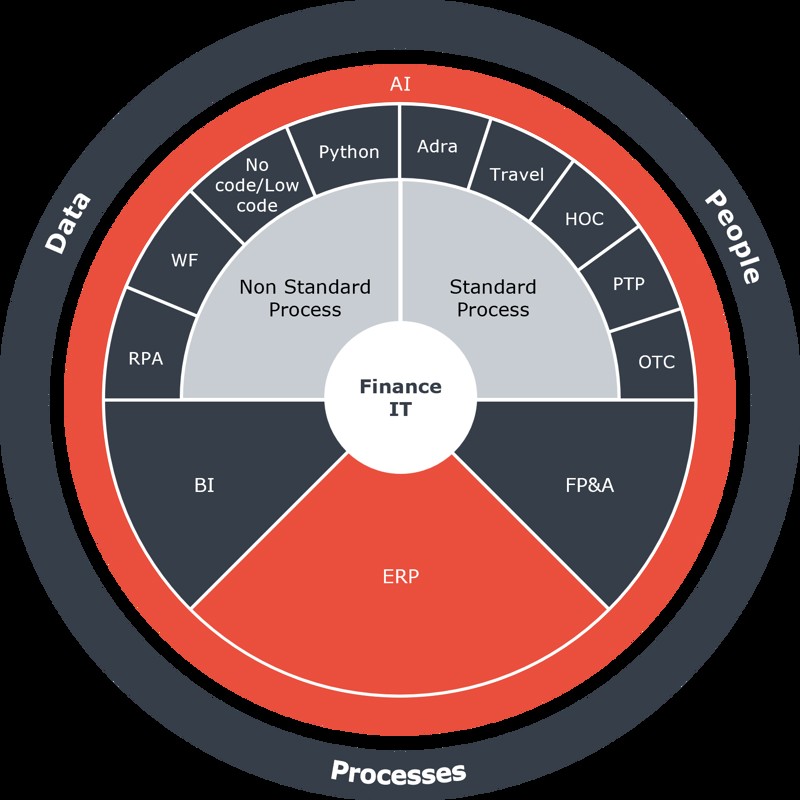You probably know Søren Friis Alexandersen. Perhaps you would not recognise him in the street, but you know his work. He is the Principal Product Manager for Microsoft's ERP system Business Central. And he has agreed to tell us about his work developing usable AI solutions that create value for millions of companies worldwide.
When Søren Friis Alexandersen started at Microsoft nine years ago, AI was synonymous with classic analytical machine learning and was not a core focus area for Microsoft in their ERP products at that time. But the developments in recent years have opened new possibilities.
Because although LLMs, which work with language and text, do not on the surface rhyme with ERP, they have proven to be the key to rethinking something that has not changed for a long time, namely manual processes.
"The overall processes that an ERP system supports can vary slightly from company to company, but fundamentally they have not changed in many years. Finance is still finance. But with generative AI, we have begun to be able to remove some of the classic bottlenecks out in companies, because the system is capable of doing something human-like – and doing it faster than a human ever could," explains Søren Friis Alexandersen.
Agents
One of the ways Søren Friis Alexandersen and his team have chosen to implement AI in Business Central is through agents – a specific user entity in the product, which has certain rights, an area of responsibility and a process it needs to perform, and within which it can operate.
And precisely this relative autonomy within a defined set of guidelines is the key to understanding the agent concept.
"An agent has a role it needs to perform. It does not just get the keys to the kingdom and can do whatever it wants," explains Søren Friis Alexandersen and elaborates:
"I view the agent as a kind of employee, in principle. And just like an employee, it can also face a choice where it does not know what the right thing to do is – and then it involves the user."
The balance between human in the loop and autonomy
Overall, it is important for Søren Friis Alexandersen that as a user of Business Central, you have the ability to adjust the agent's level of autonomy.
"We would rather involve the user a little too much to begin with, so the user can follow the agent's work in more detail and be involved in more aspects of the process. An agent is not turned on by default, for example – you have to do that yourself," he says and explains that you can run the agent in a state where you are in the loop on some decisions until you become comfortable with how it works.
"Then you can later increase the autonomy, so it only involves a human when necessary. It is a fundamental idea that a user should only be involved if it adds value. Either in the form of eliminating risk or better decisions."
And there are several factors that determine when a human should be involved in an AI process.
"In some places, it is the customer's needs or some industry-specific things that require human in the loop. In other places, it is because we assess that it would be good to have a human involved – for example, as an anti-fraud measure. So if, for instance, the amount on a received invoice is higher than it usually is from that supplier for that service, a human who knows the history needs to come in and can assess whether there is a legitimate reason for it."
Tasks where there is an immediate financial impact or tasks involving customer contact have a high risk level and thus require more user involvement.
"At the moment I am working on an invoice flow agent, which handles invoices from suppliers. In the first version, the end scenario is that the agent has created the invoice so it is ready for the company's approval process. It has not been posted, so it is a kind of draft," he explains.
"In the first version, the agent will stop here, but in later versions we imagine that the agent sends the invoice for approval and posts the invoice when it has been approved by all stakeholders, if that is what the company wants to happen. Because it is always an opt-in – and the greater the autonomy, the more you have to choose it yourself."
Starts where most people use the product
But how did Søren Friis Alexandersen and his team decide where to start implementing AI in Business Central? The answer is that they looked at where most people use the product.
"We tackled the sales process first because it is so pervasive. Everyone has sales of some kind, and everyone has a sales document they need to create – a quote or an order or an invoice," explains Søren Friis Alexandersen. And that has resulted in the Sales Order Agent.
The next step, which Søren Friis Alexandersen is working on right now and hopes to release in autumn 2025, is an agent that operates within the supplier side, and which can handle invoice flows, among other things. And there has been high demand for this for a long time.
"Invoice flows are something companies have tried to automate for decades, because nobody thinks it is fun to sit and register invoices, and it really scales poorly. We often hear from CFOs that they wish their finance departments could spend less time handling invoices and more time on controlling and other high-value tasks. So the more time AI can free up in the finance department, the more time they have to advise and be a sparring partner for the rest of the company," he explains.
Another reason to start with the most used modules is that Business Central's AI features should create value for all companies – regardless of size.
"Actually, we tend to start a bit further down in customer size, because that is the largest possible customer group, and then we narrow down a bit more and specialize a bit more later. Here, the invoice flow agent is a bit special, as it is relevant for companies of all sizes and industries. So it is a somewhat rare opportunity to create something valuable for every single Business Central customer."
And there is yet another important point about starting with the most used features: "We also try to identify what provides the most use of AI, because then we can get more feedback," says Søren Friis Alexandersen with a smile.

Digitization circle
It’s not a bug, it’s a feature
It's not just the users who need to get to know AI.
"AI is also relatively new for us at Microsoft, so we have had to learn what it can do and how it can be used in a specific scenario," explains Søren Friis Alexandersen. "It is not because we expect to fail, but we cannot get it right 100% of the time, so we need to put something on the market, get some feedback and improve it."
"Fail fast is the Software as a Service mantra. But can we do that with an ERP? Personally, I am not sure we can," he ponders.
"My top priority is to avoid disrupting customers' processes. There is an inherent conflict in that and the desire to continuously give customers more through new and improved features. This is not only a challenge for AI features."
He thinks for a moment and then adds: "I think we need to set the bar a bit higher, because we might not get another chance to show that the value is there. At least as things look now – perhaps it will be different in five years, when we are all more used to using AI."
And this has resulted in Søren Friis Alexandersen and his team finding new ways to test AI functions.
About Søren Friis Alexandersen
Søren has worked in the IT industry since the mid-90s and always with one foot in the ERP camp. Partly with end customers and with consulting and development houses, and for the last decade with Microsoft in the development department in Kgs. Lyngby, which is the headquarters for Dynamics 365 Business Central, formerly Navision. Søren holds the role of Principal Product Manager in the development team and has finance as his focus area. Søren is fundamentally a technical strategist and thrives best when he learns something new and can work with and lead people toward a common goal.
"To accommodate the desire to release new AI functionality and receive quick feedback, we have begun to devise ways to release new features to a selected group of customers and suppliers, who can then test it in a sandbox environment and give us feedback, without, so to speak, disturbing all customers or missing their needs. In these times, experiments are necessary, and we need to create a space for this – based on market feedback, so we can deliver maximum value."
Before AI, users had a different form of trust in – and patience with – new features. "If we previously released a new feature that did not work as intended, users would refrain from using it, or they would ask whether it really was supposed to work that way. But they would not question whether it would work the same way tomorrow," explains Søren Friis Alexandersen.
AI has a bit more variance built into its output. "It is a feature, not a bug, but we are not accustomed to a feature varying in that way – especially not in an ERP system. Sometimes it is acceptable, and other times it is not acceptable at all."
There is a significant difference in how creative an AI should be, depending on which feature is concerned. An invoice flow agent, for example, should preferably suggest the same way to process an invoice each time.
"These are two different ways we need to control AI. When is creativity acceptable, and how many chances do we get before the user says, 'this is not for me'? Will they try again in a week, or have they written off that feature? This is a challenge we need to solve, and this is where the aforementioned feedback process plays an important role," says Søren Friis Alexandersen.
AI first
Because AI is Microsoft's major investment right now, and it is a task they must succeed with. This means, among other things, that it has become Søren Friis Alexandersen's mandate to figure out how he can use AI to fulfil customers' wishes.
But a company that was not created to produce technology and platforms does not necessarily need to think AI first, he believes. "It is quite conceivable that they can benefit from AI in some form. But they also get that as users of Business Central, because we release AI features as part of the product they already use. The point is that if you use Business Central, you automatically get AI features without having to define and create an AI implementation project yourself as a company."
He thinks for a moment and then adds that it often makes sense for a non-tech company to look at its business strategy and tactical initiatives through an AI lens, as long as it always stems from the business strategy.
"It may be that you have overlooked something or have unexplored opportunities because the technology was not available. In that way, AI can help open some doors that were previously closed. So you can rethink your strategy, but I do not think it should be AI at the top and then business strategy afterwards – it needs to be the other way around."
The future is full of AI possibilities
Before we conclude the interview, we need to satisfy our curiosity. What does Søren Friis Alexandersen believe the future holds for AI – at least within the Microsoft framework?
He thinks for a moment. "Well, there are so many possibilities, especially in finance, to go even deeper and create more solutions," he responds. "We do not lack ideas – it is more our capacity and resources that limit what we can manage to develop."
He hesitates again briefly and then adds, "Right now we are only looking 6-12 months ahead, and it becomes really difficult to say what will happen after that. Because the only thing we know is that AI is here to stay."
Do you need sparring?
We would very much like to help you implement the setup that provides the most value in your company – whether it concerns AI or ERP. Contact us for a no-obligation conversation.



 en
en
 da
da


